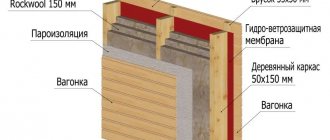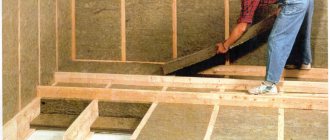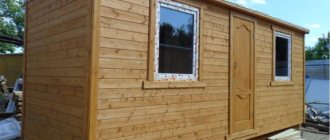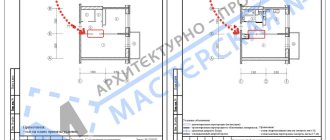Modern design does not ignore attic and attic spaces and considers them valuable living space. Very often, an empty room under the roof is converted into bedrooms, a study, a children's room, or used as a billiard room. It is the low ceiling, under the slope of the roof, that allows you to create a cozy atmosphere for relaxation.
Roof insulation scheme.
However, in order for this additional area to become a residential part at any time of the year, you need to take care of its heating. It is no secret that heating an attic is a rather complex technical task, which first of all begins with the process of thermal insulation of the roof. It is this kind of work that will allow you to retain heat and use the room for year-round use.
Attic heating
Attic is an attic-type room in residential buildings. Installation of utilities and heating of the attic are necessary conditions for comfortable use of the room as a bedroom, playroom, nursery, office. The attic heating system solves a number of problems:
- maintains a stable positive temperature in the cold season,
- does not allow the room to freeze,
- prevents the formation of ice and a decrease in the performance characteristics of building and finishing materials.
Properly designed attic heating in a house consumes a minimal amount of energy, does not increase energy consumption during the heating season, allows you to regulate the temperature in the room and is responsible for a healthy microclimate.
Attic heating: modern methods
There are several ways to heat the attic in a bathhouse and a country house. The first of them is connection to the common boiler room of the cottage. A pipeline is laid in the attic, radiators are installed through which the coolant circulates - water heated in the boiler room. When choosing the optimal method for heating the room, it is recommended to take into account the following disadvantages of a water heating system for the attic:
- The load on the boiler increases: if it was not originally designed to heat the attic, then the temperature in other rooms will drop and fuel consumption will increase.
- The attic is removed from the boiler: the coolant reaches the attic at a lower temperature, having already given off heat to other rooms. This reduces the efficiency of heating the attic, or leads to the need to install a large number of radiators.
Benefits of using solar energy for attic heating
- Autonomy.
Heating equipment powered by solar energy does not require connection to the electrical network or the use of other fuel. - Easy to install.
The products are installed on walls or on the roof. Installation is simple and fast; no complex design documentation is required. - Effective work.
The devices maintain a positive attic temperature throughout the autumn-winter period.
Attic heating using solar energy is used in residential buildings in the USA, Canada, Russia, Europe and the CIS.
Gas heating system
A country house can also be heated using gas, but a prerequisite is the presence of a gas main nearby. Gas-based heaters are considered the most efficient, as they can warm up the temperature in the house in a fairly short period.
Gas can be used not only for organizing a heating system. You can also divert the gas to the kitchen and use it for cooking.
If there is no gas main near the country house, there is an alternative option - a gas cylinder.
In order to organize gas heating of the attic and other rooms in a country house, you must have certain knowledge and skills. Compared to stove heating, gas equipment will be much more expensive. However, this is where the advantages of stove heating end. Gas is considered a cheaper coolant, and there is also no need to look for storage space. There is no need to bring it and it will always be available if supplied from the highway.
Insulation of attic floors with sawdust
Sawdust is finely ground wood.
- naturalness;
- absence of toxic impurities;
- light weight;
- availability of material.
Technology of attic insulation with sawdust
Before you start insulating them with sawdust, you need to prepare them. Namely, mix cement and water with sawdust in a ratio of 10:1:1.
Pour the prepared mixture onto the attic floor and level it. It is worth noting that sawdust can only be used as insulation without using a frame in a non-residential attic. Otherwise, when walking on the floor, the sawdust will be compressed and the concrete screed will collapse.
build a cellular structure from timber. Pour a solution with sawdust inside each cell. The advantage of this method is that a subfloor can be laid over the timber. And the attic will be usable
Insulation of attic floors with sawdust
Fireplace
When giving preference to a fireplace, you should remember some features when installing it. If this heating method was not taken into account when developing the project, the floor will have to be strengthened. For the simple reason that the fireplace itself already has sufficient weight, and when fired, its mass increases several times more. The ideal option to make the attic heated would be a lightweight fireplace with a lightweight pipe structure, or an electric fireplace. It is the latter heating method that is safe and easiest to use.
Installation of a heating boiler in the attic
- Is it even possible to install heating boilers in the attic and second floor of the house? According to experts, this is not the best option, but in extreme cases, if there is no other way out, you can go for it, observing certain conditions;
- Which boiler can be installed above the first floor of the house? With a closed combustion chamber! It is much safer than the traditional one, although it costs half as much. Condensing boilers are suitable, in which the combustion chamber is always closed. In this case, there will be no risk of carbon monoxide poisoning, and the room will not cool down while the boiler is operating;
- It’s clear about the closed combustion chamber, but still, which boiler is ideal for installation in the attic? Wall-mounted gas, power up to 30 kW. Such boilers are compact, do not take up little space, and do not require a separate room. The indicated power will be quite enough to provide heat in a cottage designed for one family, that is, a relatively small one. The main thing is that the wall can support the weight of the boiler. However, we can solve this issue even in frame buildings;
- And if the boiler runs on solid or liquid fuel, not gas, can it be installed in the attic? Theoretically, yes. However, think about how you will service a solid fuel boiler on the top floor? You will have to constantly carry briquettes, coal and firewood up the stairs. And solid fuel boilers weigh a lot; the ceilings will need to be strengthened. Liquid fuel boilers are noisy and emit an unpleasant odor, so they are absolutely not suitable for installation on upper floors;
- What should the chimney be like if the boiler is installed in the attic or second floor? This is where problems can arise. In general, the height of the chimney for a gas heating boiler should be at least four meters. Imagine if such a pipe rises above your roof. This can ruin the appearance of the house. You can get rid of the need to build such a high chimney if you choose a boiler with a closed combustion chamber that has a coaxial pipe. For boilers with a power of up to 30 kW, which we recommend for installation in attics and second floors, the chimney can be routed directly through the outer wall. In this case, the pipe outlet should be located at a height of 2.5 meters from the ground, but in the case of an attic this is not a problem. The nearest window from the chimney going through the wall should be at least half a meter;
- What should the heating system be like if the boiler is installed above the first floor? Closed! This is a must. With an open heating system, when fluid circulation in the system occurs naturally, all heating devices are located above the boiler itself. In the case of installation in the attic or second floor, this condition for normal operation of the heating system cannot be maintained. Therefore, it becomes mandatory to install a circulation pump, which will become part of a closed heating system for the house;
- Will there be enough natural ventilation for a boiler in the attic? In general, yes. But for greater reliability and safety, experts advise making an unclosable hole 30 centimeters from the floor. The exhaust vent is located under the ceiling. The total area of such ventilation should be at least 200 square centimeters.
We state: a wall-mounted gas boiler with a closed combustion chamber and a circulation pump, in addition, can be safely installed and used in the attic or second floor of a private house. published econet.ru
If you have any questions on this topic, ask them to the experts and readers of our project here.
Radiator installation
They are included in the general heating system of the house. In principle, there is nothing particularly complicated. But there are a number of nuances that you should be aware of.
- Is the boiler's power sufficient to prevent it from operating at maximum capacity with the additional load of an attic? Otherwise, the heating device will not last long. And replacing with a new unit is also not a pleasant prospect. Firstly, such equipment is expensive. Secondly, the question will arise of what to do with a used boiler.
- Most likely, you will need to install another pump or purchase a more powerful one. The same thing - what to do with the old one, which is in working order? And the problem with the pumping device will have to be solved, since the attic means not only an increase in the length of the route, but also an increase in the coolant to a height.
Attic life under the roof
Usually the attic becomes such a favorite place in the house that there is a desire to spend time in it not only in the summer, but also when there is severe frost outside the windows. Therefore, owners of attic houses often need to provide heating in the upper part of the house. You can provide good heating in different ways, not forgetting that the attic must already be insulated.
Connection to the lower floor heating system
In this case, the entire house will be heated by one system. If previously the parameters of the pump and boiler were calculated only for their use on one floor, the equipment should be replaced with a more powerful one. The necessary components are additionally supplied to the attic from the base heating system - pipes and radiators, and for air heating - air ducts.
Electrical devices
Using old-style electrical appliances is not economical due to high energy consumption, which is expensive. Modern electric convectors allow you to reduce costs. Their installation is not difficult: you just need to choose a place for the device and connect it to the power supply. Energy savings are achieved due to the fact that the convector does not operate constantly.
Wall-mounted electric convector for your attic
The owner sets the temperature to which the air should be heated. When the device’s sensors detect that the temperature has reached this level, the convector turns off until the readings drop. However, you need to take into account that to heat the attic you may need more than one such device, and this will create an additional load on the wiring and increase costs.
Heating by fireplace
When deciding to use this heating option, you need to remember that the weight of the fireplace is not small. Consequently, the floor at its location will have to be strengthened. To reduce pressure on the ceiling, it is recommended to use a fireplace with light pipes in the attic.
The fireplace in the attic also serves a decorative function.
You also need to be prepared for the fact that when using a fireplace as a heating medium in the attic, you will have to constantly bring heavy fuel into the attic floor and carry its waste down, making additional efforts.
Heating system
The method is to create a system designed only for heating the attic. This option is suitable for attic conditions, especially if a stove is used to heat the first floor, or it is not possible to connect to the main heating line of the house.
In a heating scheme of this type, the main place is occupied by a boiler that runs on any available fuel. Other elements of the system are pumping equipment, a complex that ensures the supply of air and the removal of waste products, pipelines, and the necessary fittings.
The heating boiler in the attic looks pretty good
It is important to decide on the type of circulation. If it is natural, then it is assumed that there is no pump consuming energy, which is an advantage
But at the same time, this option has many disadvantages, including an increased diameter of pipelines, strict observance of slopes, and certain difficulties in management.
It is most convenient to use a two-pipe scheme in the attic with a pump that provides forced circulation - it will contribute to optimal heat distribution.
Warm floor
This system is based on the property of warm air to rise. This way you can make your attic floors truly functional! Heating is carried out due to the uniform distribution of heat transfer components in the floor space. These could be electrical cables or pipes containing heated water.
Cables can be installed under any type of coverage. If the floor is wooden, a layer of thermal insulation is placed between the joists, and a mesh with a laid cable is suspended above it. A covering is laid on top. Cable heating is a good option for use in the attic.
Installation of heated floors in the attic
The water method of heating the attic is used less frequently. This is due to the creation of a large load on the floor. To support the weight of the entire heating system, the ceiling must be concrete. A boiler is used as a source of water. This system is most often used for autonomous heating.
Thus, attic owners have the opportunity to choose the appropriate method for maintaining heat, which will help create coziness and comfort.
There are many ways, which one to choose?
Before you begin to develop a heating system, the attic must be well and correctly insulated. Next there are several options:
- If the house already has a working heating system, then you can install additional pipes and batteries to it. In this case, if the pump is weak, it will need to be replaced with a more powerful one so that it can cope with the increased load;
- When heating a house with air, you can connect additional air ducts to the main line, which lead to the attic;
- Another method is good old heating with electric appliances;
- And the most attractive option for many is to install a fireplace. It has good performance and safety indicators, but you will always have to ensure the availability of solid fuel, which adds additional hassle.
However, the most correct solution would be to install an autonomous heating system. How to heat an attic? This requires the heating system itself, which consists of a heating boiler, a system for removing combustion products and air supply, radiators, piping and pumping equipment. If the house has a centralized gas supply, the boiler operates from it. If there is none, then the boiler can run on electricity, liquid or solid fuel.
We heat the attic space or how to do heating in a house with an attic correctly
There are two ways to use a country house - live in it periodically, for example, only in the summer, or permanently. Today we will analyze the second option, in particular, we will focus on projects with an attic floor. In this case, you will need efficient heating for the attic space, which can be autonomous or connected to the general heating system of the house. Let's look at it in more detail.
The photo shows methods of heating the attic floor
Preparation
In any case, we will first need to properly insulate the attic, otherwise the cost of heating it will be very high. Since the floor is located in direct contact with the roof, it is necessary to carry out work on its thermal insulation.
- mineral wool,
- polyurethane foam,
- foam class G1,
- foamed polymers.
Advice: pay special attention to the insulation of the attic; the better you do it, the more comfortable the living conditions in it will be, and the less money you will have to spend on additional heating. High-quality heating is impossible without proper roof insulation
High-quality heating is impossible without proper roof insulation
Selecting a heating system
If the house is just being built, it is necessary to provide heating for the attic floor at the design stage. However, as construction practice shows, most often the attic space is turned into an additional living area after all the work has been completed.
In this case, you cannot do without additional costs associated with wiring the necessary communications and choosing the optimal option for heating the room:
- "warm floor" system,
- fireplace installation,
- autonomous heating system, the price of which may vary,
- connecting the floor to the finished heating system of the house.
Do-it-yourself attic heating using infrared panels
What to pay attention to
Whatever you choose, you must first develop a heating system design, in which you try to take into account all the design features of the building, the need for materials, their cost and quantity.
The heating diagram for a cottage with an attic will allow you to understand:
- where to install the necessary equipment,
- how to lay out pipes so that you can get the maximum effect from the distribution,
- Where is the best place to place ventilation?
General heating scheme for a house with an attic
Don't hesitate to seek professional help to get a safe and effective system. Although, if you have certain abilities and the necessary materials, you can do the heating of the attic floor with your own hands.
- boiler,
- circulation pump,
- pipelines,
- systems for air supply and removal of fuel combustion products.
The heating boiler should be selected depending on the availability and ease of use of certain types of fuel. Its power must correspond to the size of the room. You can calculate them yourself or get them from specialists.
Tip: the standard calculation of heating power is 1 kW per 10 m2. In this case, the ceiling height is assumed to be 2.5-2.7 m.
Stove or fireplace
An excellent option for a heat source in the attic, which can also become an interior decoration. The main question that remains to be resolved before installing the fireplace is whether the ceilings will withstand it, since the structure has significant weight. It may be necessary to carry out work to strengthen them.
Using a fireplace as a heat source
Tip: the load can be reduced by using metal pipes and lightweight refractory bricks.
You can also purchase ready-made structures made of cast iron or steel. Such fireplace stoves are capable of creating a comfortable temperature in a room up to 200 m2.
- objects of high fire hazard,
- arrangement requires the use of non-combustible materials in the interior, properly installed chimneys and high-quality ventilation.
Tip: to reduce the risk of fire, install structures at some distance from the walls or place them in the middle of the room.
Using an electric fireplace does not require much maintenance and is safer, although electricity will increase your heating costs. To reduce them, you can install convectors that will automatically turn off after reaching a certain temperature in the room.
Installation of a steel water heating convector
A house with an attic floor has an excellent appearance and can be used year-round or from time to time. A properly executed heating system allows you to create a comfortable temperature in the room under the roof.
Automatic control system for gas contamination and gas leakage protection
Dangerous properties of gas fuel:
- the ability of gas to form fire-explosive mixtures with air;
- suffocating power of gas.
The components of gas fuel do not have a strong toxicological effect on the human body, but at concentrations that reduce the volume fraction of oxygen in the inhaled air to 16%, they cause suffocation.
When gas burns, reactions occur that produce harmful substances, as well as products of incomplete combustion.
Carbon monoxide (carbon monoxide) is formed as a result of incomplete combustion of fuel. A gas boiler or water heater can become a source of carbon monoxide if the air supply and flue gas removal system is faulty (insufficient draft in the chimney).
Carbon monoxide has a highly targeted mechanism of action on the human body, including death. In addition, the gas is colorless, tasteless and odorless, which increases the risk of poisoning. Signs of poisoning: headache and dizziness; there is tinnitus, shortness of breath, rapid heartbeat, flickering before the eyes, redness of the face, general weakness, nausea, and sometimes vomiting; in severe cases, convulsions, loss of consciousness, coma. Concentrations in the air of more than 0.1% lead to death within one hour. Experiments on young rats showed that a CO concentration of 0.02% in the air slows down their growth and reduces activity compared to the control group.
Gas alarm - gas leak sensor
of gas alarms for methane and carbon monoxide in residential buildings and apartments containing gas boilers, hot water heaters, stoves and other gas equipment
The methane gas alarm serves as a leakage sensor for household natural or liquefied gas from gas equipment. The carbon monoxide alarm is triggered in the event of malfunctions in the smoke exhaust system and the entry of flue gases into the room.
Gas sensors must be triggered when the gas concentration in the room reaches 10% of the LPL of natural gas and the CO content in the air is more than 20 mg/m3. Gas alarms must control high-speed shut-off valves installed at the gas inlet into the room and shut off the gas supply based on a signal from the gas sensor.
NCPRP and VKPRP are the lower (upper) concentration limit of flame propagation - the minimum (maximum) concentration of a flammable substance (gas, flammable liquid vapor) in a homogeneous mixture with an oxidizer (air, etc.) at which it is possible for a flame to spread through the mixture to any distance from ignition source (open external flame, spark discharge).
If the concentration of a flammable substance in a mixture is less than the lower limit of flame propagation, such a mixture cannot burn and explode, since the heat released near the ignition source is not enough to heat the mixture to the ignition temperature.
If the concentration of the flammable substance in the mixture is between the lower and upper limits of flame propagation, the ignited mixture ignites and burns both near the ignition source and when it is removed. This mixture is explosive.
If the concentration of a flammable substance in the mixture exceeds the upper limit of flame propagation, then the amount of oxidizer in the mixture is insufficient for complete combustion of the combustible substance.
The range of concentration values between the LCPRP and the VCPRP in the “combustible gas - oxidizer” system, corresponding to the ability of the mixture to ignite, forms the ignition region.
System for automatic control of gas contamination and protection against gas leaks in the boiler room of a private house: 1- carbon monoxide gas contamination alarm; 2 - natural gas alarm; 3 - shut-off valve on the gas pipeline; 4 - gas boiler; 5 - a detector in the house, notifies the residents of the house with light and sound.
Indoor gas control systems with automatic shutdown of gas supply in residential buildings should be provided when installing gas equipment, regardless of the installation location and its power.
The installation of a shut-off valve on the gas pipeline should be provided: - in front of gas meters (if a disconnecting device at the inlet cannot be used to turn off the meter); — in front of household gas appliances, stoves, cooking boilers, heating stoves, gas equipment and instrumentation; — in front of burners and igniters of gas-using equipment; — at the gas pipeline entry into the room, when a gas meter with a disconnecting device is placed in it at a distance of more than 10 m from the entry point.
Gas alarm in the cottage kitchen: 1 - natural gas alarm; 2 - shut-off valve on the gas pipe.
Read: “How to properly install a gas alarm in your home”
Next article:
How to properly make a chimney for a boiler in a private house.
Previous article:
How to make a house warm. Energy saving house.
What is the main source of energy for heating your home?
Vote! Find out what others have chosen.
Look!
— all polls
More articles on this topic
- Heating with a solid fuel boiler with a heat accumulator tank
- Frost index on the map
- Installation of internal sewerage in a private house
- We are building a wood-burning house with walls made of firewood - logs
- Calculation of the load on the foundation. Calculation of the foundation base
- How to remove old wallpaper from a wall or ceiling
- How to build a house cheaply - inexpensively
- Installation of plastic windows at the dacha
Features of the event
Usually in a cold attic only the ceiling is insulated. Then the roof truss system is left open so that it can be freely inspected and problems that arise can be corrected. If you insulate the roof with mineral wool, it becomes an attic, which can be used for a different purpose than the attic.
It is very important that the insulation is done correctly, otherwise condensation will form. Accumulating on the ceiling, moisture will seep through the ceilings
Mold and mildew may appear. And the rafters will rot from the inside.
When using mineral wool as insulation, consider its weight. The ceiling and floors must withstand the expected load with a margin, the structure must be reliable.
Instructions for insulating the attic floor with mineral wool on the video:
When planning your work, make calculations: how much material do you need to purchase? Its quantity depends on the area on which the material will be laid and the number of layers. The thickness of the thermal insulation layer depends on the climate of the region.
Step by step instructions
First, prepare the “territory”, clear the ceiling of possible debris and thyrsus. Metal roofing elements should be painted with oil paint to prevent condensation from accumulating on them.
Then a lining material is laid on the ceiling as a vapor barrier layer. If it is not there, the mineral wool will absorb all the moisture from the warm, humid air that rises from the living rooms.
Over time, it will lose its thermal insulation qualities. A budget option is to use glassine; a vapor barrier film will cost more. It needs to be laid with a slight overlap, the joints should be fixed (glued with tape or secured with wooden slats).
Place mineral wool between the joists tightly, without gaps or cracks. The joints of the material also need to be taped.
Place clean, dry, even boards on top of the joists. They will be the floor in the attic. And the mineral wool will be ventilated, “breathe” under them, and will dry out in case of moisture.
This installation is sufficient if waterproofing material is laid under the roof and there are no gaps in the attic.
If there is no waterproofing material under the roof, then it is worth covering the thermal insulating mineral insulation with a vapor barrier. The easiest way is to attach the plastic film with thin cross bars.
Mineral wool is ideal for insulating wooden floors. You can use any type: in rolls or in slabs. Choose a material of the desired density, follow the installation instructions, then the room will be warm and comfortable for a long time.
Thermal insulation work
The most affordable thermal insulation material is polystyrene foam. Foam sheets are usually laid from the inside of the attic, leaving a gap of 5 mm between them. The gaps between the plates are foamed after installation of the material.
This approach to organizing thermal insulation is due to the natural shrinkage of the roof covering. If you lay sheets of foam plastic close together, then under the influence of the weight of the roof they will begin to press on each other and become deformed. Thanks to polyurethane foam, this process is reduced to zero, and cold bridges do not form. Among the disadvantages of polystyrene foam, it is worth noting its sensitivity to moisture. The material easily becomes damp, and mold and mildew develop on its surface. Therefore, in humid regions the use of polystyrene foam is not advisable.
Another popular thermal insulation material is mineral wool. It has low thermal conductivity, provides high-quality sound insulation, and is resistant to moisture and fire. The material is laid in the same way as foam boards. However, additional layers of vapor and waterproofing will extend the service life of the material.
Insulating the attic with polyurethane foam has been practiced more and more recently. The structure of this material resembles polyurethane foam, and its properties after drying are similar to mineral wool. However, no additional layers are required for its application, since the material is water-resistant and has good vapor barrier.
Polyurethane foam is applied very quickly using a special sprayer, having previously protected the face and body with thick clothing and a mask.
Types and characteristics
The material is obtained from molten blast furnace slag, stone (rocks) or glass. The structure of these fibers is thin, randomly arranged villi, ranging from 2 to 60 mm in length. This insulation is produced in the form of mats or slabs. In order for the fibers to better adhere to each other, the slabs are additionally impregnated with special oil (to repel moisture) and phenol alcohol.
Depending on the origin, they differ:
- Glass wool. It is made from a molten mixture of broken glass, sand, limestone, and soda. The fibers are 15-50 mm long and their thickness is 5-15 microns. The material is chemically resistant, difficult to ignite (withstands up to +500 o C).
Stone wool. To make it, gabbro-basalt rocks are melted. The thickness of the fibers is 4-12 microns, and their length is up to 16 mm. It heats up to 300 o C without igniting.
Conclusion
A house with an attic floor has an excellent appearance and can be used year-round or from time to time. A properly executed heating system allows you to create a comfortable temperature in the room under the roof.
To do this, it can be autonomous or connected to the general heating circuit of the house. The video in the article will help you find additional information on this topic.
Sources:
https://teplospec.com/montazh-remont/kak-sdelat-otoplenie-mansardy-populyarnye-varianty-obogreva.html https://mastergrad.com/forums/t88173-odnotrubnaya-sistema-otopleniya-v-chastnom-dome -s-mansardoy/ https://gidroguru.com/otoplenie/1325-kak-sdelat-otoplenie-v-dome-s-mansardoj
Insulation of a cold attic with mineral wool
A vapor barrier is placed under the mineral wool.
To insulate the ceiling of a cold attic with mineral wool, you can take material of any density, from low to high. At the same time, it is still preferable to choose lighter materials so as not to create additional loads on the beams. Some experts are inclined to believe that glass wool is better suited for insulating an attic with mineral wool than stone wool. The latter is too brittle, and it weighs a lot. Also read: “Which insulation to choose for walls and ceilings.”
As you already understand, insulation of a cold attic of a private house with mineral wool is carried out by laying thermal insulation between the load-bearing beams directly on the rough ceiling of the first floor. Due to the high hygroscopicity of mineral wool, it is necessary to use a vapor barrier film. In principle, even simple polyethylene can be used. There will be no special loads on the film and if installed carefully it will not tear. To be completely confident in the reliability of the protective layer, you need to use a polypropylene vapor barrier reinforced with fiberglass mesh.
Insulating the attic with mineral wool, technology:
- the supporting beams are sewn up from below - this is the rough ceiling of the first floor;
- on the attic side, a vapor barrier is laid on the rough covering;
- Mineral wool is placed on top of the film.
Vapor barrier tapes should be laid overlapping, the joints should be taped with double-sided tape. The mineral wool is placed outward so that there are no cold bridges at the junction of the insulation with the beams.
Insulating a cold attic with mineral wool is always preceded by calculating the thickness of the thermal insulation. In any case, the layer will be at least 10 cm. Mineral wool is available in a thickness of 5 cm. It is better to lay thermal insulation in two layers with offset joints. This will eliminate the possibility of heat loss through the joints of the mineral wool sheets.
After insulating the attic floor with mineral wool, you can immediately lay the floor on top of the beams. It is advisable to first cover the insulation with waterproofing - a material that does not allow water to pass through, but allows steam to pass through, but only in one direction
It is important not to confuse which side to lay the waterproofing on, otherwise moisture will accumulate in the mineral wool, as a result of which the thermal conductivity of the material will increase significantly
It is quite possible to use a fireplace to heat a country house. To do this, a heat exchanger is built above the firebox.
Read about how to choose the sizes of brackets for radiators here.
Premises requirement
The best solution for the attic is wall-mounted turbocharged gas heating, which only requires a ceiling height of 2.3 m, and a sufficiently strong wall that can withstand the weight of a fairly light boiler - about 50 kg. There are no additional requirements for the fire resistance of the walls and the quality of the chimney; the coaxial chimney is guaranteed to remove combustion products, and the boiler is fireproof. A turbocharged boiler will solve the rather complex problems of guaranteed gas removal.
For chimney boilers, in addition to the required height of the room, it is necessary to ensure the height of the chimney - 5 m, the volume of the room - 15 m3. The air flow through the opening is at least 200 cm2, the boiler must be more than 0.5 m from the window.
Solid fuel boilers are quite heavy; taking into account fuel storage, the load on the ceiling is quite large - up to 0.5 tons. This must be taken into account when placing the boiler room, reinforcing the ceiling, installing retaining structures.
Liquid fuel boilers are the most problematic in terms of requirements for the boiler room premises. It is necessary to prevent fuel from leaking out of the combustion chamber if there are problems with the pipeline. To do this, it is necessary to waterproof the floor with an overlap of at least 10 cm onto the walls. The firebox threshold must be at least 4 cm in height. These measures are more likely to be preventive measures; in case of real accidents they help little. In addition, the smell of diesel fuel and oils penetrates even to the first floor.
The most important requirement is fire safety. Which is not only to protect combustible structures from the elevated temperature of the heat source, but to protect the entire room from possible problems. The smartest thing is to make a heating project linked to a specific boiler; for a gas boiler this is definitely necessary. If you don’t want to do this, then it’s better to invite fire supervision, at least not officially, to identify possible troubles.
Insulation of heating pipes in the basement Pipes and plumbing
House heating costs are increasing every year. Each owner is looking for ways to save: the boiler turns on periodically, or constantly works only at a minimum, and so on. The use of such methods leads to a significant decrease in the temperature in the house. But few people think about how efficiently the living area is heated, because most of the heat is lost on the way to it.
If heat loss can be minimized, then the rooms will warm up better and faster; therefore, continuous operation of the boiler will not be required, and it will be possible to resort to savings without compromising the temperature. Since boilers are often located in basements and other utility rooms, we will consider how to insulate heating pipes in the basement and other possible places where the system passes.
Autonomous heating
An autonomous attic heating system makes it possible to maintain the required temperature throughout the year.
Such a system includes the following mandatory elements:
- boiler;
- chimney;
- air ducts;
- pipes;
- batteries;
- circulation pump.
The boiler is the heart of autonomous attic heating. At the request of the owner, it can be electric, gas, liquid or solid fuel, or combined. The location of the boiler, the type of fuel, as well as the method of removing combustion products are the main issues that need to be decided before heating the attic.











